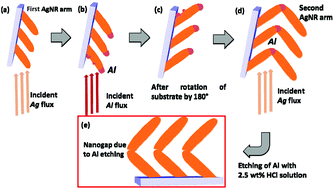Vertically standing nanoporous Al–Ag zig-zag silver nanorod arrays for highly active SERS substrates†
Abstract
Surface enhanced Raman scattering (SERS) has emerged as a promising technique for chemical and biological sensing. “Hot spots” are the areas on noble metal nanostructures where light is highly concentrated into small volumes and enhances the local electromagnetic field near the metal nanostructures. These hot spots have been claimed to provide extraordinary enhancements to the SERS signal. Here, we report the fabrication of nanoporous zig-zag Ag nanostructures with built-in high density hot spots. The zig-zag Ag nanostructures were fabricated by glancing angle deposition of Ag and Al, with Al deposited on the edges of the zig-zag structure during growth. A 2.5 wt% HCl solution was used for etching Al from the Ag–Al zig-zag structure. The etching process produced intra-particle gaps by leaching less stable Al from fully alloyed Al–Ag nanostructures. This step of mild acid etching (2.5% v/v HCl for 45 min) allowed the formation of Raman hot spots on the elbows of zig-zag nanorods while maintaining the zig-zag morphology of highly active Ag nanostructures. A high enhancement factor of ∼106 was observed on nanoporous zig-zag Ag nanostructures obtained by de-alloying, making them very appealing as Raman sensors. The role played by nanogap hot spots in Ag zig-zag nanostructures towards SERS enhancement is modelled by using finite difference time domain (FDTD) simulations.



 Please wait while we load your content...
Please wait while we load your content...